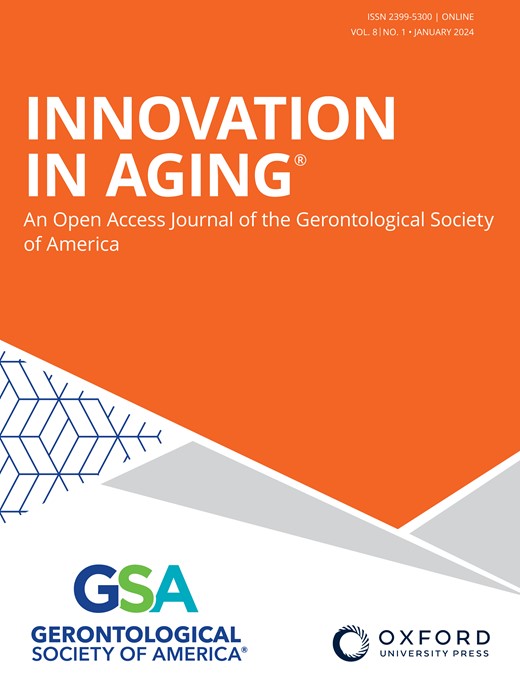PRECARIOUS HOUSING BEFORE, DURING, AND AFTER AN EPISODE OF LATE-LIFE HOMELESSNESS
IF 4.9
3区 医学
Q1 GERIATRICS & GERONTOLOGY
引用次数: 0
Abstract
Abstract This qualitative study aims to understand how the living environments occupied by older adults before, during, and after an episode of homelessness inform their access to a healthy, stable, and dignified life. Indicators of accommodation, quality, and service integration are explored using the Aging in the Right Place conceptual framework. Through partnerships with a homeless shelter, a meal site, and a mental health outreach team in Columbus, OH, demographic questionnaires and semi-structured interviews were completed with 22 older adults with an episode of late-life homelessness. Nine direct service providers were also interviewed. Interviews were analyzed using the team-based flexible coding method in Nvivo 1.6.1. Results indicated that low or no income in late life forced older adults to occupy a continuum of precarious and low-quality living environments that include shared housing, doubling up, emergency shelters, institutional settings, and living on the land. AIRP indicators are discussed for each. Conflict, death of a support person, mental and behavioral challenges, unit deterioration, rental price increases, and social isolation forced OA down the housing continuum and into homelessness. Sub-optimal conditions interacted with age to exacerbate health conditions, create social isolation, and expose OA to harm. Informal and formal relationships, emergency shelter services, vouchers, and specific behaviors and attitudes were identified as critical for securing affordable and accommodating housing in which to age. Understanding the experiences of OPEH who are striving to occupy their subjective right place to age can help service providers and policymakers meet the unique needs of precariously housed OA.晚年无家可归之前、期间和之后的住房不稳定情况
摘要 本定性研究旨在了解老年人在无家可归之前、期间和之后所居住的生活环境如何影响他们获得健康、稳定和有尊严的生活。研究采用 "在合适的地方养老 "概念框架,探讨了住宿、质量和服务整合的指标。通过与俄亥俄州哥伦布市的一个无家可归者收容所、一个供餐点和一个心理健康外展团队合作,对 22 名晚年无家可归的老年人进行了人口调查问卷和半结构化访谈。此外,还采访了九名直接服务提供者。访谈采用 Nvivo 1.6.1 中基于团队的灵活编码方法进行分析。结果表明,晚年低收入或无收入迫使老年人在一系列不稳定和低质量的生活环境中生活,这些环境包括合租房、双人间、紧急避难所、机构环境和在土地上生活。AIRP 指标将逐一讨论。冲突、赡养人死亡、精神和行为挑战、单元破损、租金价格上涨以及社会孤立迫使 OA 在住房连续体中走下坡路,沦为无家可归者。不理想的条件与年龄相互作用,加剧了健康状况,造成社会隔离,并使 OA 面临伤害。非正式和正式的关系、紧急庇护所服务、优惠券以及特定的行为和态度被认为是获得可负担和可容纳的住房以安度晚年的关键。了解 OPEH 努力占据其主观上适合养老的地方的经历,有助于服务提供者和政策制定者满足居住不稳定的 OA 的独特需求。
本文章由计算机程序翻译,如有差异,请以英文原文为准。
求助全文
约1分钟内获得全文
求助全文
来源期刊

Innovation in Aging
GERIATRICS & GERONTOLOGY-
CiteScore
4.10
自引率
0.00%
发文量
72
审稿时长
15 weeks
期刊介绍:
Innovation in Aging, an interdisciplinary Open Access journal of the Gerontological Society of America (GSA), is dedicated to publishing innovative, conceptually robust, and methodologically rigorous research focused on aging and the life course. The journal aims to present studies with the potential to significantly enhance the health, functionality, and overall well-being of older adults by translating scientific insights into practical applications. Research published in the journal spans a variety of settings, including community, clinical, and laboratory contexts, with a clear emphasis on issues that are directly pertinent to aging and the dynamics of life over time. The content of the journal mirrors the diverse research interests of GSA members and encompasses a range of study types. These include the validation of new conceptual or theoretical models, assessments of factors impacting the health and well-being of older adults, evaluations of interventions and policies, the implementation of groundbreaking research methodologies, interdisciplinary research that adapts concepts and methods from other fields to aging studies, and the use of modeling and simulations to understand factors and processes influencing aging outcomes. The journal welcomes contributions from scholars across various disciplines, such as technology, engineering, architecture, economics, business, law, political science, public policy, education, public health, social and psychological sciences, biomedical and health sciences, and the humanities and arts, reflecting a holistic approach to advancing knowledge in gerontology.
 求助内容:
求助内容: 应助结果提醒方式:
应助结果提醒方式:


